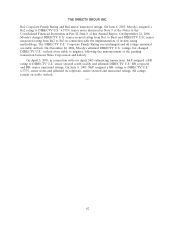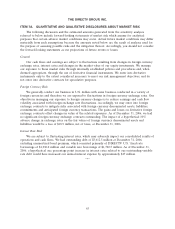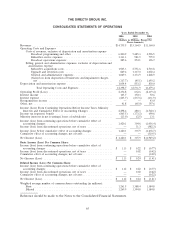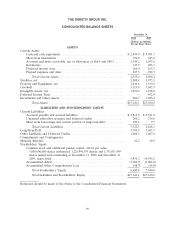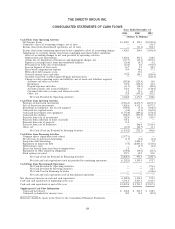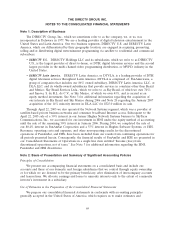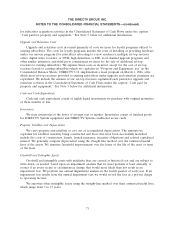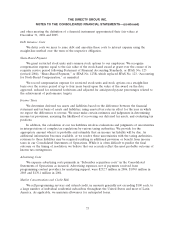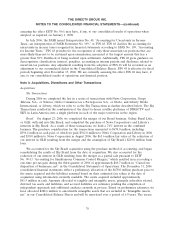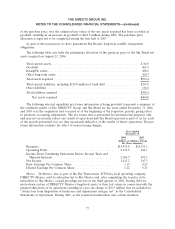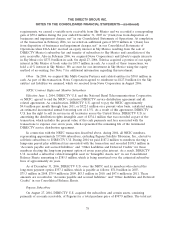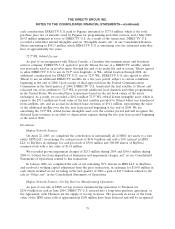DIRECTV 2006 Annual Report Download - page 83
Download and view the complete annual report
Please find page 83 of the 2006 DIRECTV annual report below. You can navigate through the pages in the report by either clicking on the pages listed below, or by using the keyword search tool below to find specific information within the annual report.THE DIRECTV GROUP, INC.
NOTES TO THE CONSOLIDATED FINANCIAL STATEMENTS —(continued)
Valuation of Long-Lived Assets
We evaluate the carrying value of long-lived assets to be held and used, other than goodwill and
intangible assets with indefinite lives, when events and circumstances warrant such a review. We
consider the carrying value of a long-lived asset impaired when the anticipated undiscounted future
cash flow from such asset is separately identifiable and is less than its carrying value. In that event, we
would recognize a loss based on the amount by which the carrying value exceeds the fair value of the
long-lived asset. We determine fair value primarily using estimated future cash flows associated with the
asset under review, discounted at a rate commensurate with the risk involved, or other valuation
techniques. We determine losses on long-lived assets to be disposed of in a similar manner, except that
we reduce the fair value for the cost of disposal.
Foreign Currency
The U.S. dollar is the functional currency of most of our foreign operations. We recognize gains
and losses resulting from remeasurement of these operations foreign currency denominated assets,
liabilities and transactions into the U.S. dollar in the Consolidated Statements of Operations.
We also have foreign operations where the local currency is their functional currency. Accordingly,
these foreign entities translate assets and liabilities from their local currencies to U.S. dollars using
year-end exchange rates while income and expense accounts are translated at the average rates in effect
during the year. We record the resulting translation adjustment as part of accumulated other
comprehensive income (loss), which we refer to as OCI, a separate component of stockholders’ equity.
Investments and Financial Instruments
We maintain investments in equity securities of unaffiliated companies. We carry non-marketable
equity securities at cost. We consider marketable equity securities available-for-sale and they are carried
at current fair value based on quoted market prices with unrealized gains or losses (excluding
other-than-temporary losses), net of taxes, reported as part of OCI. We continually review our
investments to determine whether a decline in fair value below the cost basis is
‘‘other-than-temporary.’’
We consider, among other factors: the magnitude and duration of the decline; the financial health
and business outlook of the investee, including industry and sector performance, changes in technology,
and operational and financing cash flow factors; and our intent and ability to hold the investment. If we
judge the decline in fair value to be other-than-temporary, we write-down the cost basis of the security
to fair value and recognize the amount in the Consolidated Statements of Operations as part of
‘‘Other, net’’ and record it as a reclassification adjustment from OCI.
Short-term investments include investments in auction rate securities, which are considered
available-for-sale and carried at fair value.
We account for investments in which we own at least 20% of the voting securities or have
significant influence under the equity method of accounting. We record equity method investments at
cost and adjust for the appropriate share of the net earnings or losses of the investee. We record
investee losses up to the amount of the investment plus advances and loans made to the investee, and
financial guarantees made on behalf of the investee.
The carrying value of cash and cash equivalents, short-term investments, accounts and notes
receivable, investments and other assets, accounts payable, and amounts included in accrued liabilities
72


